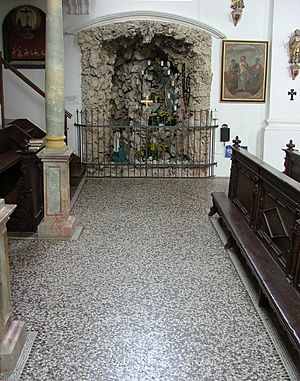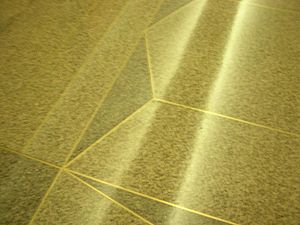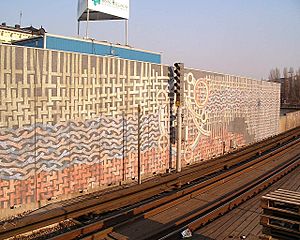Terrazzo facts for kids
Terrazzo is a special building material. It looks like polished rock chips are decorating its surface. It's a mix of small chips held together by a "binder," which is like a strong glue. Terrazzo can be poured right where it's needed, or it can be made into tiles beforehand. People use it for floors and walls. It's made from chips of things like marble, quartz, granite, or glass. These chips are mixed with a binder, which can be like cement or a special chemical. After it's poured, terrazzo is hardened, ground smooth, and polished to a shiny finish. Sometimes, it's given a textured surface instead of a flat one.
Contents
How Terrazzo Is Made
Terrazzo workers create beautiful floors, walkways, and panels. They do this by showing off marble chips and other small stones on the surface. This is done on top of finished concrete or a special epoxy-resin.
Making traditional terrazzo with marble chips and cement involves three layers:
- First, workers make a strong, flat concrete base. This base is usually about 3 to 4 inches (7.6 to 10 cm) thick.
- Next, they add a 1-inch (2.54 cm) layer of sandy concrete.
- Before this layer dries, workers place thin metal strips into the concrete. These strips create patterns or separate different colors of terrazzo.
- For the final layer, workers mix fine marble chips. They might add color to this mixture. While it's still wet, they toss more marble chips onto the surface. Then, they roll a light roller over everything.
In the 1970s, a new type of terrazzo appeared. It uses a special plastic-like material called polymer as its binder. Today, most terrazzo is made with epoxy. This "thin-set" terrazzo has many good points:
- It comes in more colors.
- It's thinner (about 1/4 to 3/8 inch or 0.63 to 0.95 cm thick).
- It's lighter and faster to install.
- It doesn't let water through.
- It's stronger and cracks less.
However, epoxy terrazzo can only be used inside buildings. If used outdoors, it can lose its color and peel. Cement-based terrazzo works well both inside and outside.
Besides marble, other materials can be used for the chips. These include mother of pearl and abalone shell. Recycled materials like glass, porcelain, concrete, and metal can also be used. Workers can create shapes and designs by bending the divider strips. They can also use a special water-jet cutting machine to make detailed patterns.
Once the terrazzo is completely dry, helpers grind it with a heavy machine. This machine is like a floor polisher, but much bigger. Any small dips left by grinding are filled with a matching material called grout. This makes the surface smooth and even. Finally, terrazzo experts clean, polish, and seal the dry surface. This makes it shine brightly.
History of Terrazzo
Venetian construction workers first invented terrazzo. They needed a cheap way to make floors. So, they used leftover marble chips from fancy building projects. They would set these chips in clay to make floors for the patios around their homes.
The first terrazzo was made from marble chips, clay, and even goat's milk! Goat's milk was used as a sealer. It helped the terrazzo look wet and shiny, like new marble. Making terrazzo became much easier after the 1920s. That's when electric grinding machines and other power tools were invented.
Ancient Terrazzo
Archaeologists use the word terrazzo to describe very old floors. These floors were found in early Stone Age buildings (around 9,000–8,000 BC) in Western Asia. These ancient floors were made from burnt lime and clay. They were colored red with ochre and polished. Crushed limestone mixed in gave them a slightly spotted look.
It's interesting that people learned to use fire to make burnt lime long before they started making pottery. This lime was also used to attach tools to handles.
At an ancient village called Cayönü in eastern Turkey, about 90 square meters of terrazzo floors have been found. In another ancient village, Nevali Cori, the floors are about 80 square meters. They are 15 cm thick and contain about 10-15% lime.
Other places where ancient terrazzo floors have been found include Nevali Cori, Göbekli Tepe, Jericho, and Kastros in Cyprus.
Terrazzo and the Environment
Terrazzo flooring is actually a very old "recycled" product! It was first made centuries ago by Venetian workers. They used the waste chips left over from cutting marble slabs.
Today, terrazzo is still a great choice for the environment. It's very strong and lasts a long time, often as long as the building itself. It also has no harmful chemicals called volatile organic compounds (VOCs). This means it helps keep the air inside buildings clean. Modern terrazzo still uses recycled materials.
Terrazzo materials can help buildings earn points for being "green." This is part of the U.S. Green Building Council (USGBC) LEED rating system.
When we think about how good a building material is for the environment, we look at many things:
- How long it lasts.
- What it's made of.
- If it uses recycled materials.
- How much care it needs.
- How much energy was used to make it.
- Its total environmental impact over its lifetime.
Being durable (lasting a long time) is key for green building. Terrazzo floors can be polished again and again. This means you reuse them instead of replacing them. It costs much less to restore an old terrazzo floor than to put in a new one. Even floors that are 100 years old often just need small fixes and a new polish to look beautiful again.
Terrazzo floors, both cement and epoxy types, need very little care. You just need to sweep and damp mop them regularly. Sometimes, you can spray and buff them. Using wax or harsh chemical cleaners can actually harm the finish. Once a year, you can strip and reseal them using water-based products.
Terrazzo is made from natural stones, recycled glass or plastic, and cement or epoxy binders. The binders make up about 25-30% of the floor's volume. The rest is made of chips, colors, and fillers.
Using recycled glass or stone from granite and marble factories increases the amount of recycled content in terrazzo. Even the aluminum strips that divide colors can be recycled.
Both cement-based and epoxy terrazzo systems are made of materials with zero VOCs. This means they don't release harmful gases into the air over time. The smooth, non-porous surface of terrazzo also stops germs and moisture from growing.
Another good thing about terrazzo is that it can often be made right where it's installed. This means less waste from shipping and lower transportation costs.
On many building projects, terrazzo can help earn several LEED points. For example, it can contribute to points for recycled content and indoor air quality.
Images for kids
-
Terrazzo with a Native-American design at the Hoover Dam
See also
 In Spanish: Terrazo para niños
In Spanish: Terrazo para niños





